(完整word版)初中英语形容词副词
- 格式:doc
- 大小:47.01 KB
- 文档页数:7
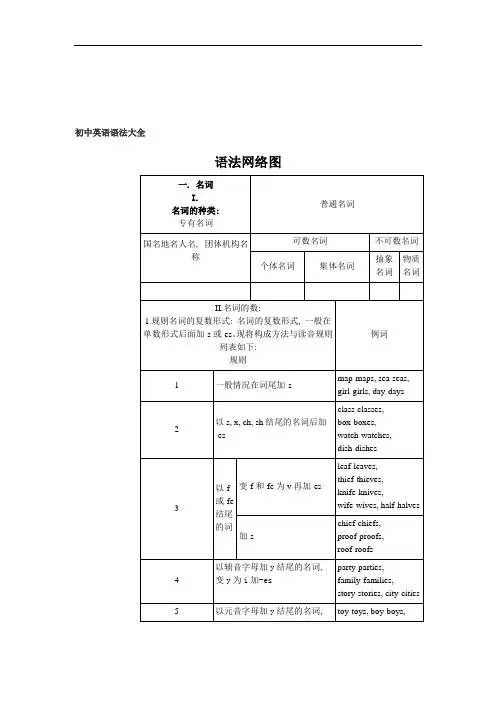
初中英语语法大全语法网络图十二。
倒装句十三。
虚拟语气十四。
重要句型1.It was not until midnight that he finished his task.2.Not until he came back from abroad was I able to see him again. 3.The harder you work, the greater progress you will make.4.He walked around the house, gun in hand.5.May you be in good health!6.Wish you a pleasant journey back home!7.The professor was a humorous man with big nose and deep-set eyes.8.What surprised me most was his imagination and patience.9.He lay on the grass, with his eyes looking at the sky and his hands under his head. 10.Sitting under the tree are Mr.Green and his first teacher.11.On the wall hang two pictures of famous scientists.12.Looking back upon those past years, he couldn’t help feeling very proud.13.No sooner(Hardly) had he arrived at the theatre than(when) the play started.14.Young as he is, he has learned advanced mathematics.15.How I regret the hours wasted in the woods and fields!16.There stands a beautiful vase in the corner of the room.17.Ten miles north of the town lies a paper factory.18.There goes the bell.19.Nowhere has the world ever seen such a bird as here.20.It is no use crying for help.21.If only I had been your student in the middle school!22.It is believed that such a thing will not happen again.23.Only when he explained did I realize the reason for this.24.“He works particularly hard.”“So he does, and so do you.”25.Not only Alice but also Jane and Mary are tired of having one examination after another.26.Such was Albert Einstein, a simple person of great achievements.十五。
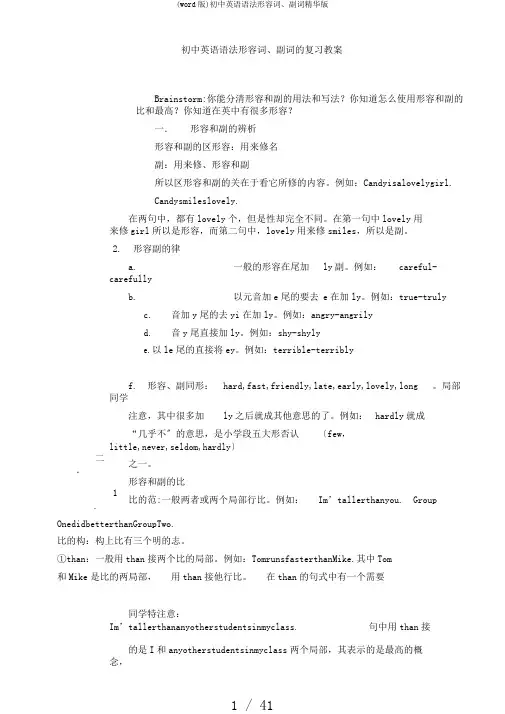
初中英语语法形容词、副词的复习教案Brainstorm:你能分清形容和副的用法和写法?你知道怎么使用形容和副的比和最高?你知道在英中有很多形容?一.形容和副的辨析形容和副的区形容:用来修名副:用来修、形容和副所以区形容和副的关在于看它所修的内容。
例如:Candyisalovelygirl.Candysmileslovely.在两句中,都有lovely个,但是性却完全不同。
在第一句中lovely用来修girl所以是形容,而第二句中,lovely用来修smiles,所以是副。
2. 形容副的律a. 一般的形容在尾加ly副。
例如:careful-carefullyb. 以元音加e尾的要去 e在加ly。
例如:true-trulyc.音加y尾的去yi在加ly。
例如:angry-angrilyd.音y尾直接加ly。
例如:shy-shylye.以le尾的直接将ey。
例如:terrible-terribly二.1.f. 形容、副同形:hard,fast,friendly,late,early,lovely,long 。
局部同学注意,其中很多加ly之后就成其他意思的了。
例如:hardly就成“几乎不〞的意思,是小学段五大形否认〔few,little,never,seldom,hardly〕之一。
形容和副的比比的范:一般两者或两个局部行比。
例如:Im’tallerthanyou.GroupOnedidbetterthanGroupTwo.比的构:构上比有三个明的志。
①than:一般用than接两个比的局部。
例如:TomrunsfasterthanMike.其中Tom和Mike是比的两局部,用than接他行比。
在than的句式中有一个需要同学特注意:Im’tallerthananyotherstudentsinmyclass.句中用than接的是I和anyotherstudentsinmyclass两个局部,其表示的是最高的概念,我比我班其他同学都要高,其中anyother⋯⋯是固定搭配,任何其他的。
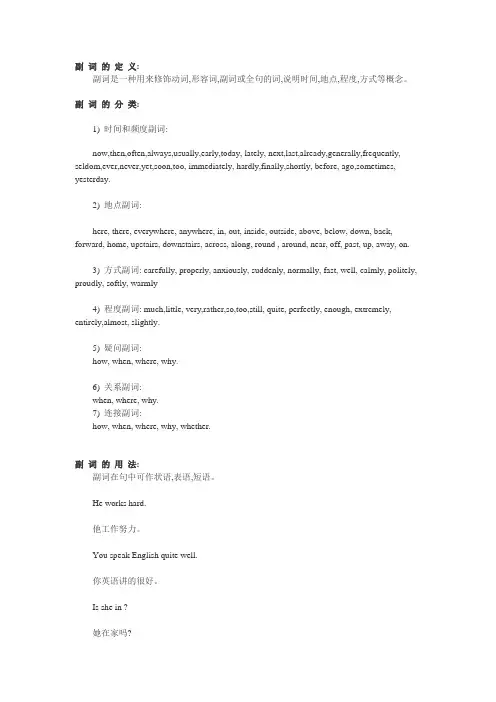
副词的定义:副词是一种用来修饰动词,形容词,副词或全句的词,说明时间,地点,程度,方式等概念。
副词的分类:1) 时间和频度副词:now,then,often,always,usually,early,today, lately, next,last,already,generally,frequently, seldom,ever,never,yet,soon,too, immediately, hardly,finally,shortly, before, ago,sometimes, yesterday.2) 地点副词:here, there, everywhere, anywhere, in, out, inside, outside, above, below, down, back, forward, home, upstairs, downstairs, across, along, round , around, near, off, past, up, away, on.3) 方式副词: carefully, properly, anxiously, suddenly, normally, fast, well, calmly, politely, proudly, softly, warmly4) 程度副词: much,little, very,rather,so,too,still, quite, perfectly, enough, extremely, entirely,almost, slightly.5) 疑问副词:how, when, where, why.6) 关系副词:when, where, why.7) 连接副词:how, when, where, why, whether.副词的用法:副词在句中可作状语,表语,短语。
He works hard.他工作努力。
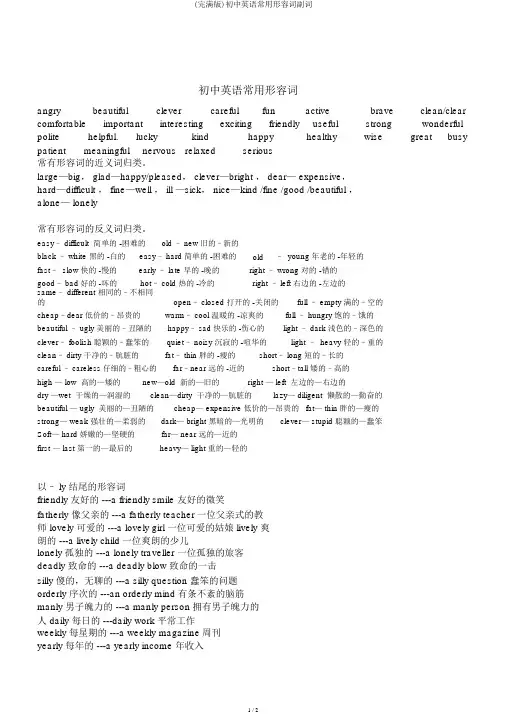
初中英语常用形容词angry beautiful clever careful fun active brave clean/clear comfortable important interesting exciting friendly useful strong wonderful polite helpful.lucky kind happy healthy wise great busy patient meaningful nervous relaxed serious常有形容词的近义词归类。
large—big, glad—happy/pleased, clever—bright , dear— expensive,hard—difficult , fine—well , ill —sick, nice—kind /fine /good /beautiful ,alone— lonely常有形容词的反义词归类。
easy– difficult 简单的 -困难的old – new 旧的–新的black – white 黑的 -白的easy– hard 简单的 -困难的old– young 年老的 -年轻的fast– slow 快的 -慢的early – late 早的 -晚的right – wrong 对的 -错的good– bad 好的 -坏的hot– cold 热的 -冷的right – left 右边的 -左边的same– different 相同的–不相同的open– closed 打开的 -关闭的full – empty 满的–空的cheap–dear 低价的–昂贵的warm– cool 温暖的 -凉爽的full – hungry 饱的–饿的beautiful – ugly 美丽的–丑陋的happy– sad 快乐的 -伤心的light – dark 浅色的–深色的clever– foolish 聪颖的–蠢笨的quiet– noisy 沉寂的 -喧华的light – heavy 轻的–重的clean– dirty 干净的–肮脏的fat– thin 胖的 -瘦的short– long 短的–长的careful – careless 仔细的–粗心的far–near 远的 -近的short–tall 矮的–高的high — low 高的—矮的new—old 新的—旧的right — left 左边的—右边的dry —wet 干燥的—润湿的clean—dirty 干净的—肮脏的lazy— diligent 懒散的—勤奋的beautiful — ugly 美丽的—丑陋的cheap— expensive 低价的—昂贵的 fat— thin 胖的—瘦的strong— weak 强壮的—柔弱的dark— bright 黑暗的—光明的clever— stupid 聪颖的—蠢笨Soft— hard 娇嫩的—坚硬的far— near 远的—近的first — last 第一的—最后的heavy— light 重的—轻的以– ly 结尾的形容词friendly 友好的 ---a friendly smile 友好的微笑fatherly 像父亲的 ---a fatherly teacher一位父亲式的教师 lovely 可爱的 ---a lovely girl 一位可爱的姑娘 lively 爽朗的 ---a lively child 一位爽朗的少儿lonely 孤独的 ---a lonely traveller 一位孤独的旅客deadly 致命的 ---a deadly blow 致命的一击silly 傻的,无聊的 ---a silly question 蠢笨的问题orderly 序次的 ---an orderly mind 有条不紊的脑筋manly 男子魄力的 ---a manly person 拥有男子魄力的人 daily 每日的 ---daily work 平常工作weekly 每星期的 ---a weekly magazine周刊yearly 每年的 ---a yearly income 年收入副词的分类副词按词汇意义可分为:方式副词: well , fast,slowly , carefully , quickly程度副词: very , much, enough, almost, rather, quite地点副词: here, there, out, somewhere, abroad, home哪些单词既是形容词又是副词初中常有的有 :fast, hard, enough, early, late,t,high,far方式副词:well (好地)fast(快地 )carefully(小心地 )quickly (快地)sadly(伤心地)badly (严重地,特别)carelessly(粗心地)slowly (慢慢地)politelyproperly (合适地,完满地)(有礼貌地)proudly (骄傲地),successfully (成功地)happily (快乐地)angrily (生气地,气愤地)。
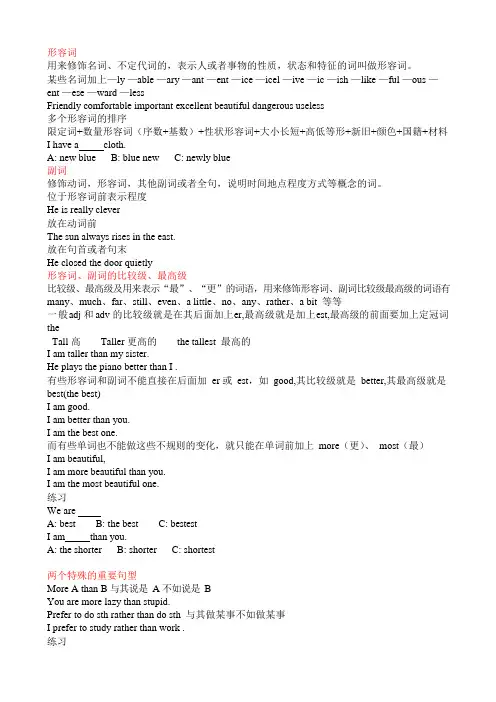
形容词用来修饰名词、不定代词的,表示人或者事物的性质,状态和特征的词叫做形容词。
某些名词加上—ly —able —ary —ant —ent —ice —icel —ive —ic —ish —like —ful —ous —ent —ese —ward —lessFriendly comfortable important excellent beautiful dangerous useless多个形容词的排序限定词+数量形容词(序数+基数)+性状形容词+大小长短+高低等形+新旧+颜色+国籍+材料I have a cloth.A: new blue B: blue new C: newly blue副词修饰动词,形容词,其他副词或者全句,说明时间地点程度方式等概念的词。
位于形容词前表示程度He is really clever放在动词前The sun always rises in the east.放在句首或者句末He closed the door quietly形容词、副词的比较级、最高级比较级、最高级及用来表示“最”、“更”的词语,用来修饰形容词、副词比较级最高级的词语有many、much、far、still、even、a little、no、any、rather、a bit 等等一般adj 和adv 的比较级就是在其后面加上er,最高级就是加上est,最高级的前面要加上定冠词theTall 高Taller 更高的the tallest 最高的I am taller than my sister.He plays the piano better than I .有些形容词和副词不能直接在后面加er 或est,如good,其比较级就是better,其最高级就是best(the best)I am good.I am better than you.I am the best one.而有些单词也不能做这些不规则的变化,就只能在单词前加上more(更)、most(最)I am beautiful,I am more beautiful than you.I am the most beautiful one.练习We areA: best B: the best C: bestestI am than you.A: the shorter B: shorter C: shortest两个特殊的重要句型More A than B 与其说是A 不如说是BYou are more lazy than stupid.Prefer to do sth rather than do sth 与其做某事不如做某事I prefer to study rather than work .练习1、I prefer rather than .A: walking taking busB: to walk take busC: walking to take bus2、You are more than .A: tired(累) lazyB: lazy tiredC: tired lazyly冠词冠词本身没有意义,不能单独存在,分为不定冠词(a/an)和定冠词the.不定冠词:元音音标开头用an 如an orange , an angel辅音音标开头用a 如a pig , a boy定冠词:the+加形容词表示某一种人the old 老人the youth 年轻人the+姓氏表示某一家人一家人the smith 斯密斯一家人用在某些特定的人、物前,用在仅此一样的事物前练习:1、smith are playing football, they bought(买) new ball today ,but it is ugly ball. A: a the anB: the a anC: the an a2、sun was so high(高)A: a B: an C: the3 、Give me hour ,I can do it. A:a B: an C: the一、名词1、名词,即用来表示人、物、地点即抽象概念等的词语(房子、汽车、博物馆、中国)2、名词可分为“专有名词”和“普通名词”,专有名词特指某些名称和个别人(lily、Tibet、WTO)。

形容词形容词的概述形容词用来描述、修饰名词或不定代词的词,表示人或物的性质、特征和状态,一般放在所修饰名词之前,若修饰不定代词则放在其后。
He is a clever boy。
他是个聪明的男孩.I want to tell you something important。
我想告诉你一些重要的事情。
有些形容词以—ly结尾,不能错当成副词brotherly 友爱的 deadly 致命的 friendly 友好的 likely 可能的 lovely 可爱的 weekly 每周一次的 yearly 每年一次的形容词比较等级的构成形容词有三个比较等级,即原级、比较级和最高级.形容词的比较级和最高级的用法1.形容词的原级as+形容词原级+as--—肯定形式,意为“……和……一样"My sister is as tall as me.我妹妹和我一样高。
not so+形容词原级+as--—否定形式,意为“……不如……”Your apple isn't sobig as mine.你的苹果不如我的大。
2.形容词的比较级形容词比较级+than,意为“比……更……”。
I am stronger than you。
我比你更强壮.3.形容词的最高级the+形容词最高级+比较范围, 意为“……最……”This book is the most interesting of all。
这本书是所有书中最有趣的.副词副词的概述副词是用来修饰动词、形容词、其他副词或全句的词,用来说明时间、地点、程度、方式、动作等.副词修饰动词时,通常放在被修饰词的后面。
He runs fast.他跑的很快副词修饰形容词时,通常放在这个形容词前面。
She is pretty beautiful 。
她是相当漂亮的.副词修饰其他副词时,通常放在被修饰副词的前面。
He runs very fast 。
他跑的非常快. 副词比较等级的构成副词比较等级的规则变化表副词的比较等级的用法1。

![(完整word版)最全初中英语语法之形容词和副词比较级和最高级[]](https://uimg.taocdn.com/e5af6e31960590c69fc3760a.webp)
形容词和副词的比较级和最高级一.形容词和副词的比较级和最高级的变化方法如下(1) 符合规则的:(2)几个不规则的形容词和副词的比较级和最高级如下表:二.形容词和副词比较级的用法注意:有些形容词,如 dead, empty, round, sure, woolen 等受本身含义的限制,没有比较级。
例题解读1. He is ________ friends than I.A. much moreB. many moreC. very moreD. too more解读:后面有可数名词复数时,many的比较级形式为many more 修饰。
应选B.2. Which is the _________ country, Japan or Australia?A. more developedB. more developingC. most developedD. most developing解读:两者比较用比较级,表示"发达"用developed, 而developing 是"发展中的" 意思3. There were _______ shops in the city in 1982 than in 1990.A. littleB. fewC. fewerD. less解读:little 不能修饰可数名词,两者比较需用比较级,所以应选C.4. If you are not free today, come another day __________.A. tooB. soC. insteadD. yet解读:instead 作副词用时意为"代替,顶替",表示前面的事情没做,而是做了后面的事。
Instead一般位于句首。
应选C.5.He can't tell us ________, I think.A. important anythingB. anything importantC. important somethingD. something important.解读:不定代词与形容词联用需后置,否定句中应该用anything而不是something. 因此应选B6. The Huang River is the second __________ river in our country.A. longB. longerC. longestD. the longest解读:"定冠词the+ 序数词+ 形容词最高级" 表示"第几大……" 应选C.7. The light in the office wasn't ________for him to read.A. enough brightB. bright enoughC. brightlyD. enough brightly解读:enough修饰名词时可前可后,修饰形容词或副词时,要后置。
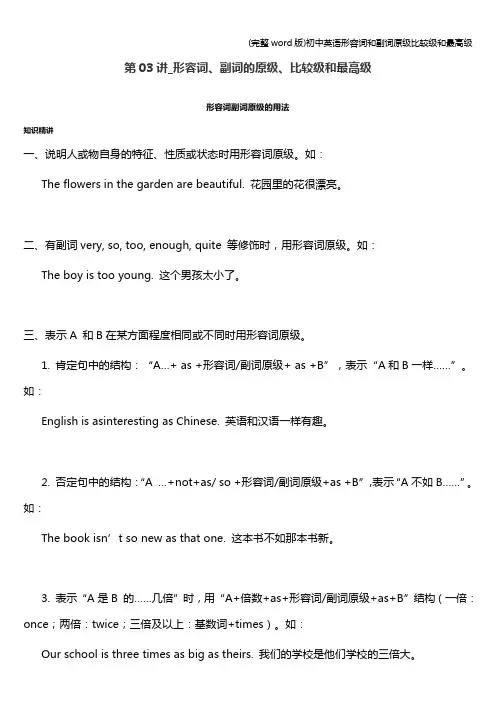
形容词副词原级的用法知识精讲一、说明人或物自身的特征、性质或状态时用形容词原级。
如:The flowers in the garden are beautiful. 花园里的花很漂亮。
二、有副词very, so, too, enough, quite 等修饰时,用形容词原级。
如:The boy is too young. 这个男孩太小了。
三、表示A 和B在某方面程度相同或不同时用形容词原级。
1. 肯定句中的结构:“A…+ as +形容词/副词原级+ as +B”,表示“A和B一样……”。
如:English is asinteresting as Chinese. 英语和汉语一样有趣。
2. 否定句中的结构:“A …+not+as/ so +形容词/副词原级+as +B”,表示“A不如B……”。
如:The book isn’t so new as that one. 这本书不如那本书新。
3. 表示“A是B 的……几倍”时,用“A+倍数+as+形容词/副词原级+as+B”结构(一倍:once;两倍:twice;三倍及以上:基数词+times)。
如:Our school is three times as big as theirs. 我们的学校是他们学校的三倍大。
一、考点:形容词副词不同级别用法的考查较为重要,同学们在学习中要注意辨别不同级别的使用。
二、补充点:否定句的结构中部分双音节和多音节形容词除使用“not …as/ so +形容词/副词原级+ as”结构外,还可使用“less+形容词/副词原级+than”结构。
如:He thinks Chinese is not as interesting as English.= He thinks Chinese is less interesting than English.他认为汉语不如英语有趣。
题模精讲题模一形容词副词原级的用法例1.1、Kate said that she didn’t feel very _________ today.A、gooderB、goodC、niceD、better例1.2、用形容词的适当形式填空。
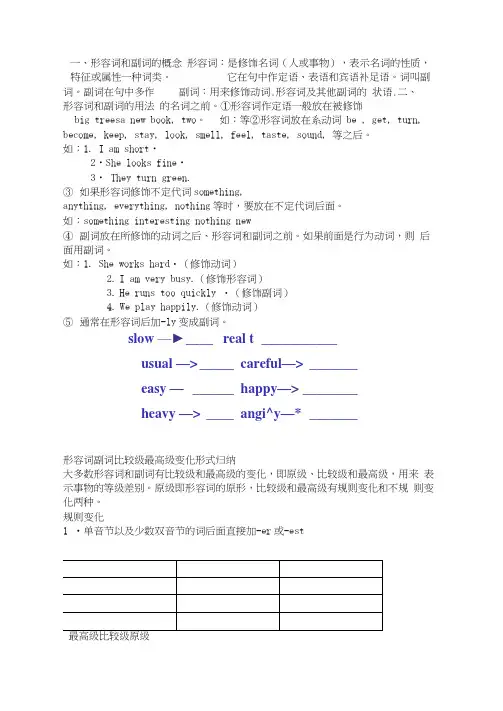
一、形容词和副词的概念形容词:是修饰名词(人或事物),表示名词的性质,特征或属性一种词类。
它在句中作定语、表语和宾语补足语。
词叫副词。
副词在句中多作副词:用来修饰动词.形容词及其他副词的状语.二、形容词和副词的用法的名词之前。
①形容词作定语一般放在被修饰big treesa new book, two。
如:等②形容词放在系动词be , get, turn, become, keep, stay, look, smell, feel, taste, sound, 等之后。
如:1. I am short・2・She looks fine・3・ They turn green.③如果形容词修饰不定代词something,anything, everything, nothing等时,要放在不定代词后面。
如:something interesting nothing new④副词放在所修饰的动词之后、形容词和副词之前。
如果前面是行为动词,则后面用副词。
如:1. She works hard・(修饰动词)2.I am very busy.(修饰形容词)3.He runs too quickly ・(修饰副词)4.We play happily.(修饰动词)⑤通常在形容词后加-ly变成副词。
slow —►____ real t ___________usual —> _____ careful—> _______easy —______ happy—> ________heavy —> ____ angi^y—* _______形容词副词比较级最高级变化形式归纳大多数形容词和副词有比较级和最高级的变化,即原级、比较级和最高级,用来表示事物的等级差别。
原级即形容词的原形,比较级和最高级有规则变化和不规则变化两种。
规则变化1 •单音节以及少数双音节的词后面直接加-er或-est最高级比较级原级tallest taller tallsmartest smarter smartshortestshorter shortesto结尾的双音节形容词末尾加特别提醒:以-y, -er, -ow, leer和healthy, funny, busy, hungry, easy, happy, early, pretty, lazy,如:heavy, dirty, clever, narrow o -stp或2.以不发音的e结尾只加最高级原级比较级nicest nice nicerfinest fine finerlargestlarge larger-est或i,再加-er3•“以辅音字母+y”结尾的词改y为最高比较原easiesteasiereasyprettiestprettierprettyhappiesthappierhappyfunniestfunnierfunnybusiestbusierbusy再加以一个元音加一个辅音字母结尾的重读闭音节词,双写后面的辅音字母,4 •一est最高级原级比较级thinnest thin thinner hottest hotter hotbiggestbigger big等词含有字母组合,且发的是长元音,不用new, few, slow, clean特别提醒: 双un构成的三音节形容词不适合上述情况,特别提醒:以形容前缀unhappy-一unhappier一一unhappiest, untidy一一untidier一一untidiest 如26.以形容词+ly构成的副词要在前面加more, most原级比较级最高级most slowly more slowly slowlymost quickly more quickly quicklymost angrily more angrily angrilymost softly more softly softlymost noisilymore noisilynoisily特另II提醒:early -- e arlier --- earliest7. ill ING分词和ED分词演变过来的形容词(包括不规则动词如know—known)只能加more或most来表示它们的比较级和最高级。
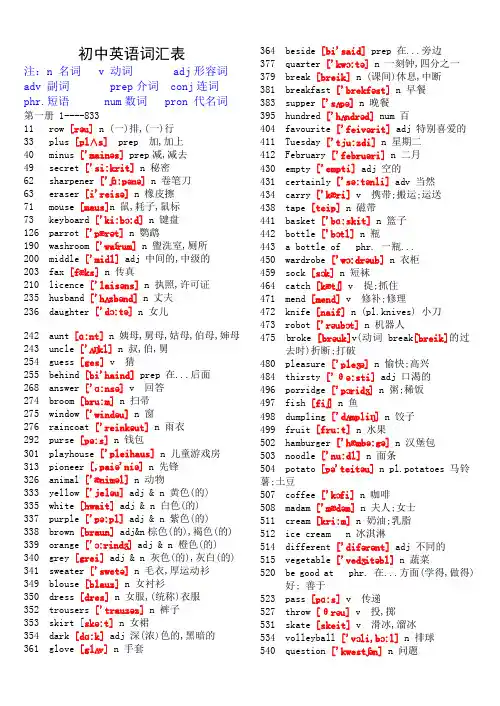
初中英语词汇表注:n 名词 v 动词 adj形容词adv 副词 prep介词 conj连词phr.短语 num数词 pron 代名词第一册 1----83311 row [rəu] n (一)排,(一)行33 plus [pl∧s] prep 加,加上40 minus ['mainəs] prep减,减去49 secret ['si:krit] n 秘密62 sharpener ['ʃɑ:pənə] n 卷笔刀63 eraser [i'reisə] n 橡皮擦71 mouse [maus]n 鼠,耗子,鼠标73 keyboard ['ki:bɔ:d] n 键盘126 parrot ['pærət] n 鹦鹉190 washroom ['waſrum] n 盥洗室,厕所200 middle ['midl] adj 中间的,中级的203 fax [fæks] n 传真210 licence ['laisəns] n 执照,许可证235 husband ['hʌzbənd] n 丈夫236 daughter ['dɔ:tə] n 女儿242 aunt [ɑ:nt] n 姨母,舅母,姑母,伯母,婶母243 uncle ['ʌŋkl] n 叔,伯,舅254 guess [ges] v 猜255 behind [bi'haind] prep 在...后面268 answer ['ɑ:nsə] v 回答274 broom [bru:m] n 扫帚275 window ['windəu] n 窗276 raincoat ['reinkəut] n 雨衣292 purse [pə:s] n 钱包301 playhouse ['pleihaus] n 儿童游戏房313 pioneer [,paiə'niə] n 先锋326 animal['æniməl] n 动物333 yellow ['jeləu] adj & n 黄色(的)335 white [hwait] adj & n 白色(的)337 purple ['pə:pl] adj & n 紫色(的)338 brown [braun] adj&n棕色(的),褐色(的) 339 orange ['ɔ:rindʒ] adj & n 橙色(的)340 grey [grei] adj & n 灰色(的),灰白(的) 341 sweater ['swetə] n 毛衣,厚运动衫349 blouse [blauz] n 女衬衫350 dress [dres] n 女服,(统称)衣服352 trousers ['trauzəz] n 裤子353 skirt [skə:t] n 女裙354 dark [dɑ:k] adj 深(浓)色的,黑暗的361 glove [glʌv] n 手套364 beside [bi'said] prep 在...旁边377 quarter ['kwɔ:tə] n 一刻钟,四分之一379 break [breik] n (课间)休息,中断381 breakfast ['brekfəst] n 早餐383 supper ['sʌpə] n 晚餐395 hundred ['hʌndrəd] num 百404 favourite ['feivərit] adj 特别喜爱的411 Tuesday ['tju:zdi] n 星期二412 February ['februəri] n 二月430 empty ['empti] adj 空的431 certainly ['sə:tənli] adv 当然434 carry ['kæri] v 携带;搬运;运送438 tape [teip] n 磁带441 basket ['bɑ:skit] n 篮子442 bottle ['bɔtl] n 瓶443 a bottle of phr. 一瓶...450 wardrobe ['wɔ:drəub] n 衣柜459 sock [sɔk] n 短袜464 catch [kætʃ] v 捉;抓住471 mend [mend] v 修补;修理472 knife [naif] n (pl.knives) 小刀473 robot ['rəubɔt] n 机器人475 broke [brəuk]v(动词break[breik]的过去时)折断;打破480 pleasure ['pleʒə] n 愉快;高兴484 thirsty['θə:sti] adj 口渴的496 porridge ['pɔridʒ] n 粥;稀饭497 fish [fiʃ] n 鱼498 dumpling ['dʌmpliŋ] n 饺子499 fruit [fru:t] n 水果502 hamburger['hæmbə:gə] n 汉堡包503 noodle ['nu:dl] n 面条504 potato [pə'teitəu] n pl.potatoes 马铃薯;土豆507 coffee ['kɔfi] n 咖啡508 madam['mædəm] n 夫人;女士511 cream [kri:m] n 奶油;乳脂512 ice cream n 冰淇淋514 different ['difərənt] adj 不同的515 vegetable ['vedʒitəbl] n 蔬菜520 be good at phr. 在...方面(学得,做得)好; 善于523 pass [pɑ:s] v 传递527 throw[θrəu] v 投,掷531 skate [skeit] v 滑冰,溜冰534 volleyball ['vɔli,bɔ:l] n 排球540 question ['kwestʃən] n 问题541 postal ['pəustəl] adj 邮政的542 code [kəud] n 密码,符号547 chess [tʃes] n 国际象棋571 lake [leik] n 湖579 Wednesday ['wenzdi] n 星期三583 Thursday['θə:zdi] n 星期四585 Monday ['mʌndei] n 星期一589 dictionary ['dikʃəneri] n 字典;词典611 straight [streit] adj 直的613 wheel [hwi:l] n 轮;机轮620 save [seiv] v 救,挽救,节省627 foreign ['fɔrin] adj 外国的628 difference ['difərəns] n 不同,差异633 Australia [ɔ:s'treiljə] n 澳大利亚639 French [frentʃ] n 法语656 country ['kʌntri] n 国家658 France [frɑ:ns] n 法国659 textbook ['tekstbuk] n 课本661 Australian [ɔ:s'treiljən]adj 澳大利亚人662 Canadian [kə'neidiən] n 加拿大人663 city ['siti] n 城664 foreigner ['fɔ:rinə] n 外国人674 different ['difərənt] adj 不同的680 vegetable ['vedʒitəbl] n 蔬菜681 restaurant ['restərɔnt] n 饭馆686 because [bi'kɔ:z] conj 因为688 machine [mə'ʃi:n] n 机器693 electronic [ilek'trɔnik] adj 电子的694 mail [meil] n 邮政,邮递696 fog [fɔg] n 雾697 smog[smɔg]n 烟雾702 farmer ['fɑ:mə] n 农民703 soldier ['səuldʒə] n 士兵,战士704 businessman ['biznismæn] n 商人705 assistant [ə'sistənt] n 助手,助理707 nurse [nə:s] n 护士709 factory ['fæktəri] n 工厂710 station ['steiʃən] n 车站,所,站712 hospital ['hɔspitl] n 医院721 medicine ['medisin] n 内服药,医学729 turn [tə:n] n (依次轮流的)顺序,轮流731 baker ['beikə] n 面包师732 artist ['ɑ:tist] n 画家,艺术家733 hobby ['hɔbi] n 业余爱好735 place [pleis] n 地点,地方742 usually ['ju:ʒuəli] adv 通常744 sometimes ['sʌmtaimz] adv 有时748 exercise ['eksəsaiz]n锻炼,做操,练习752 garden ['gɑ:dn] n 花(果,菜)园760 match [mætʃ] n 比赛,竞赛761 quickly ['kwikli] adv 迅速764 bridge [bridʒ] n 桥766 ship [ʃip] n 船,轮船783 problem ['prɔbləm] n 问题,难题787 chicken['tʃikin] n 鸡,鸡肉789 fridge [fridʒ] n 电冰箱790 list [list] n 清单,一览表,名单,目录793 kilo ['ki:ləu] n 千克,公斤796 cheap [tʃi:p] adj 便宜的797 expensive [iks'pensiv] adj 昂贵的798 tomato[tə'meitəu]n(pl.tomatoes)西红柿,蕃茄799 onion ['ʌnjən] n 洋葱800 carrot ['kærət] n 胡萝卜801 pork [pɔ:k] n 猪肉805 market ['mɑ:kit] n 市场,集市806 dollar['dɔlə]n元(美,加拿大等国的货币单位)807 cent [sent] n (货币)分808 pound [paund] n 镑(重量单位)814 minibus ['mini,bʌs] n 小型公共汽车816 price [prais] n 价格,价钱817 example [ig'zɑ:mpl] n 例子,榜样818 for example phr. 例如820 field [fi:ld] n 地,田地822 job [dʒɔb] n 工作823 bright [brait] adj 明亮的,灿烂的824 foreign ['fɔrin] adj 外国的825 sunglasses ['sʌnglɑ:siz] n 太阳镜827 language['læŋgwidʒ] n 语言830 business ['biznis] n 商业,生意,事物831 company ['kʌmpəni] n 公司832 manager['mænidʒə] n 经理,负责人833 century ['sentʃuri] n 世纪,百年第二册 834----1644834 lesson ['lesn] n 课,功课837 traffic ['træfik] n 交通841 September [sep'tembə] n 九月851 important [im'pɔ:tənt]adj重要的,重大的857 third[θə:d] num &adj 第三的858 afraid [ə'freid] adj 害怕的860 sound [saund] n & v 声音,听起来865 laugh [lɑ:f] v & n 笑,大笑,笑声866 waste [weist] n & v 浪费,废弃物868 fifth[fifθ] num & adj 第五(的)869 trip [trip] n & v 旅游,旅行872 discuss [di'skʌs] v 讨论,议论876 east [i:st] n & adj 东方(的),东部(的) 881 mountain ['mauntin] n 山,高山882 hike [haik] n & v 远足,徒步旅行885 picnic ['piknik] n 野餐886 the day after tomorrow phr. 后天887 top [tɔp] n 顶部888 problem ['prɔbləm] n 问题,难题889 quick [kwik] adj 快的,迅速的890 quickly ['kwikli] adv 快地,迅速地892 trip [trip] over phr. (被...)绊倒893 tired ['taiəd] adj 累,疲乏894 hurry ['hʌri] v 赶快,慌忙895 hurry up phr. 赶快896 tie [tai] v 捆,(系,栓)紧897 die [dai] v 死亡900 eighth [eitθ] num 第八901 salesgirl ['seilzgə:l] n 女售货员903 beautiful ['bju:təfəl] adj 美丽的,漂亮的904 together [tə'geðə] adv 一起905 autumn ['ɔ:təm] n 秋天,秋季906 festival ['festəvəl] n & adj 节日(的),喜庆(的)907 ninth [nainθ] num &adj 第九(的)909 mid-autumn n 中秋910 mooncake n 月饼911 nut [nʌt] n 坚果,坚果核912 sweet [swi:t] adj 甜的,可爱的913 inside [,in'said] prep 在...里面914 store ['in'said] n (美)商店,大百货公司915 come over phr. 过来,顺便来访916 thanksgiving [,θæŋks'giviŋ] n 感谢,感恩917 Thanksgiving=Thanksgiving Day phr. 感恩节918 get together phr. 相聚919 October [ɔk'təubə] n. 十月920 taste [teist] v 品尝,有...味道921 pie [pai] n (用肉或水果做成的)馅饼922 outside ['aut'said] prep & adv 在...外923 in the open air phr.在户外,在野外924 harvest ['hɑ:vist] n 收获925 than[ðæn] conj 比....,比较....926 another[ə'nʌðə]adj&conj另一个(的),又一个(的)927 delicious [di'liʃəs] adj 美味的,可口的928 better['betə]adj(goo或well的比较级)更好的929 pumpkin ['pʌmpkin] n 南瓜930 twelfth[twelfθ] num &adj 第十二(的) 931 turkey ['tə:ki] n 火鸡932 celebrate ['selibreit] v 庆祝933 wait [weit] v 等,等待934 feed [fi:d] v 喂,饲养935 cow [kau] n 母牛,乳牛936 interesting['intəristiŋ]adj有趣的,有意思的937 tractor['træktə] n 拖拉机938 taxi ['tæksi] n 出租汽车939 slow [sləu] adj 慢的,缓慢的940 slowly ['sləuli] adv 缓慢地941 grow [grəu] v 种植,生长942 wheat [hwi:t] n 小麦943 country ['kʌntri] n 乡村,郊外944 hear [hiə] v 听见,听说945 bleat [bli:t] v & n 羊叫(声)946 agree with phr.同意...意见(想法)符合,一致947 corn [kɔ:n] n (美)玉米,谷类庄稼948 most[məust]adj&adv(many或much的最高级)最多的949 summer ['sʌmə] n 夏天,夏季950 winter ['wintə] n 冬天,冬季951 stop [stɔp] v 停止,中止952 pick [pik] v 采摘(花,果实)953 exciting [ik'saitiŋ] adj 令人兴奋的954 town [taun] n 城镇955 star [stɑ:] n 星星,恒星956 until [ən'til] prep&pron 到...为止957 till [til] prep&pron (直)到...为止958 college ['kɔlidʒ] n 学院,高等专科学校959 farming ['fɑ:miŋ] n 农业,务农960 somebody ['sʌmbədi] pron 某人,有人961 nobody ['nəubɔdi] pron 没有人962 shall [ʃæl] v (我,我们)将,会963 zoo [zu:] n 动物园964 nothing ['nʌθiŋ] pron没有什么,没有东西965 dolphin ['dɔlfin] n 海豚966 show [ʃəu] n&v演出,展览给...看,出示967 gate [geit] n 大门970 grass [grɑ:s] n 草,草地971 dangerous ['deindʒərəs] adj 危险的972 panda ['pændə] n 熊猫973 lion ['laiən] n 狮子974 elephant ['elifənt] n 象975 monkey ['mʌŋki] n 猴子976 tiger ['taigə] n 老虎977 deer [diə] (pl.deer) n 鹿979 rabbit ['ræbit] n 兔子980 duck [dʌk] n 鸭981 fox [fɔks] n 狐狸982 horse [hɔ:s] n 马983 bear [bɛə] n 熊984 cage [keidʒ] n 笼(子),鸟笼986 forest ['fɔrist] n 森林989 fall [fɔ:l] v 落下,跌倒990 climb [klaim] v 爬,攀登992 cinema ['sinimə] n 电影院,电影993 seafood ['sifu:d] n 海鲜,海产食品994 twentieth ['twentiiθ] num 第十二998 twenty-first [,twenti'fə:st]num 第二十一999 bank [bæŋk] n 银行1000 theatre(theater['θiətə])['θiətə]n剧场,戏院1001 bookshop ['bukʃɔp] n 书店1002 toilet ['tɔilit] n 厕所1003 museum [mju:'ziəm] n 博物馆1004 front [frʌnt] adj & n 前面(的),前部1005 in front of phr. 在...前面1006 left [left] n & adj 左(的),左边(的) 1013 along [ə'lɔŋ] prep沿着,顺着一起,一道1015 turn [tə:n] v (使)转动,(使)翻动1016 turning ['tə:niŋ] n 拐弯处1018 kilometre ['kilə,mi:tə] n 公里,千米1020 coin [kɔin] n 硬币1023 moment ['məumənt] n 片刻,瞬间1025 street [stri:t] n 街道1026 next to ['nekst tə] phr. 相邻,靠近1028 lift [lift] n 电梯1032 centre['sɛntɚ](center ['sentə]) n 中心1033 popular ['pɔpjulə] adj 大众的,流行的1034 soccer ['sɔkə] n 英式足球1035 quite [kwait] adv 很,十分1036 month [mʌnθ] n 月1037 village ['vilidʒ] n 村庄,乡村1041 November [nəu'vembə] n 十一月1044 composition [,kɔmpə'ziʃən]n 作文作品1045 remember [ri'membə] v 记起,想起1046 were [wə:] v 动词be(are)的过去式1047 bit [bit] n 一点儿,小片1048 a bit [ə'bit] phr. 一点儿1049 healthy ['helθi] adj 健康的,健壮的1050 grow up ['grəu ʌp] phr. 成长,长大1051 visit ['vizit] v 参观,访问,拜访1052 ago [ə'gəu] adv 以前1053 the day before yesterday phr. 前天1054 enjoy [in'dʒɔi] v 喜欢,享受...乐趣1055 world [wə:ld] n 世界1056 at the same time phr. 同时1057 a moment ago phr. 刚才1058 just now phr. 不久以前,刚才1059 reply [ri'plai] n & v 答复,回答1061 match [mætʃ] n 比赛,竞赛1065 diary ['daiəri] n 日记1068 India ['indiə] n 印度1072 memory ['meməri] n 记忆力,存储器1073 pack [pæk]v 打包,打行李1075 umbrella [ʌm'brelə] n 伞,雨伞1076 dry [drai] adj 干的,干燥的1083 scientist ['saiəntist] n 科学家1084 invent [in'vent] v 发明,创造1090 May [mei] n 五月1091 move [mu:v] v 移动,搬动,搬家1092 understand [,ʌndə'stænd] v 懂得,理解1097 April ['eiprəl] n 四月1098 hate [heit] v 讨厌,不喜欢,憎恨1100 painting ['peintiŋ] n 油画,水彩画1102 Swedish ['swi:diʃ] adj 瑞典的,瑞典人的1103 rock [rɔk] n 摇动,摇滚乐1104 band [bænd] n 乐队1105 concert ['kɔnsət] n 音乐会,演奏会1106 give a concert phr. 开音乐会1109 journalist ['dʒə:nəlist] n记者,新闻工作者1110 famous ['feiməs] adj 有名的,著名的1114 thousand ['θauzənd] num 千1115 accident ['æksidənt] n 事故,灾难1116 careless ['kɛəlis] adj 粗心的,大意的1117 fall down phr. 倒下,跌倒,从...落下1118 break [breik] v 折断,断裂,破碎1119 go on phr. 继续1120 someone ['sʌmwʌn] pron 某人,有人1121 heart [hɑ:t] n 心(脏)1122 past [pɑ:st] n & adj 过去(的)1127 tourist ['tu:rist] n 旅游者,观光者1129 in a hurry phr. 匆忙地1130 grape [greip] n 葡萄1131 science ['saiəns] n (自然)科学1132 marry['mæri] v 结婚1133 get married phr. 结婚1134 subject ['sʌbdʒikt] n 题目,题材1137 date [deit] n 日期1138 season ['si:zn] n 季节1140 January ['dʒænjueri] n 一月1141 March [mɑ:tʃ] n 三月1142 June [dʒu:n] n 六月1143 July [dʒu:'lai] n 七月1144 August [ɔ:'gʌst] n 八月1145 December [di'sembə] n 十二月1148 weather ['weðə] n 天气1150 come out['kʌm aut]phr. (花)开,发(芽),出来1151 heavily ['hevili] adv大量地,猛烈地,厉害地1152 crop [krɔp] n 庄稼,收成1156 all the year round phr. 一年到头1158 nearly ['niəli] adv 将近,几乎1160 opposite ['ɔpəzit] adj 对面的,相反的1161 sunny ['sʌni] adj 晴朗的,阳光充足的1162 cloud [klaud] n 云1163 cloudy ['klaudi] adj 多云的,阴天的1164 wet [wet] adj 湿的1165 rainy ['reini] adj 多雨的,下雨的1166 wind [waind] n 风1167 windy ['windi] adj 有风的,风大的1168 snowy [snəui]1171 ring [riŋ] v (钟,铃等)响,摇铃1172 ring up phr. 打电话1173 west [west] n & adj 西方、西部(的) 1174 strange [streindʒ] adj 奇怪的,陌生的1175 sunshine ['sʌnʃain] n 日光,阳光1176 melon ['melən] n 瓜1177 radio ['reidiəu] n 收音机1178 report [ri'pɔ:t] n & v 报导,报告1179 north [nɔ:θ] n & v 北方(的),北部(的)1180 south [sauθ] n & v 南方(的),南部(的)1181 at times phr. 有时,偶尔1182 northeast ['nɔ:θ'i:st] n 东北,东北部1183 temperature ['tempritʃə] n 温度1184 above [ə'bʌv] prep 在...上面1185 daytime ['deitaim] n 白天1186 below [bi'ləu] prep 在...下,低于1187 northwest ['nɔ:θ'west] n 西北,西北部1188 lift [lift] v (云,雾等)消散,(雨)停止1189 worse [wə:s] adj & adv ( bad,ill的比较级)更坏,更差1190 foggy ['fɔgi] adj 有雾,多雾的1191 low [ləu] adj 低的,浅,矮的1192 birthday ['bə:θdei] n 生日1193 invite [in'vait] v 邀请,招待1194 film [film] n 影片,电影1195 hold [həuld] v 拿,握1196 hold on ['həuld ɔn] phr. (打电话时)等一等,不挂断1197 message ['mesidʒ] n 消息,信息1198 take/leave a message phr. 捎/留口信1200 sandwich ['sændwitʃ] n 三明治,夹心面包片1201 plate [pleit] n 盘子,碟子1202 candle['kændl] n 蜡烛1203 doorbell ['dɔ:bel] n 门铃1204 present ['preznt] n 礼物1205 smile [smail] n & v 微笑1206 telephone(phone [fəun]) ['telifəun]n 电话,电话机1207 double ['dʌbl]n & adj两倍(的),双倍(的)1209 take out phr. 取出1210 the same as phr. 和...相同1211 word [wə:d] n 词,单词1212 shout [ʃaut] v 呼喊,喊叫1213 turn over ['tə:n ,əuvə] phr. 把...翻过来1214 study ['stʌdi] n 书房1215 less [les] adj&adv ( little的比较级)较少的,较小的1216 less than phr. 不到,少于1217 be late for phr. 迟到1218 beef [bi:f] n 牛肉1219 help yourself to phr. 自取,随便吃1220 Christmas ['krisməs] n 圣诞节1221 during ['djuəriŋ] prep 在...的期间1222 Spring Festival n 春节1223 exam [ig'zæm] n (口语)考试1224 get-together ['gettə,geðə] n 聚会1225 put on phr. (戏剧等)上演,放(唱片等) 1226 play [plei] n 剧,戏剧1227 shower ['ʃauə] n 降雨,骤雨1228 showery ['ʃauəri] adj 降雨的,多阵雨的1229 magical ['mædʒikəl] adj 魔法(似)的1230 Rome [rəum] n 罗马(意大利首都)1231 Berlin [bə:'lin] n 柏林1232 Moscow ['mɔskəu] n 莫斯科1233 kitchen ['kitʃin] n 厨房1234 cupboard ['kʌbəd] n 碗橱,小橱(柜)1237 salt [sɔ:lt] n 盐1238 sugar ['ʃugə] n 糖1239 pepper ['pepə] n 胡椒1240 oil [ɔil] n 油1241 wine [wain] n 酒1242 beer [biə] n 啤酒1243 fork [fɔ:k] n 叉,餐叉1244 spoon [spu:n] n 匙,调羹1245 chopsticks ['tʃɔpstiks] n (常用复数)筷子1246 cabbage ['kæbidʒ] n 卷心菜,洋白菜1247 pea [pi:] n 豌豆1248 butter ['bʌtə] n 黄油1249 cheese [tʃi:z] n 乳酪1250 soup [su:p] n 汤1251 Italian [i'tæljən]n & adj意大利人(的),意大利语(的)1252 pizza ['pi:tsə] n (意大利)烤馅饼1253 Indian ['indiən] n & adj 印度人(的),印第安人(的)1254 kinds of phr. 各种各样的1255 workplace ['wə:kpleis] n 工作场所1256 seem [si:m] v 好像,似乎1257 even ['i:vən] adv 甚至,更1258 Italy ['itəli] n 意大利1259 chocolate ['tʃɔkəlit] n 巧克力,巧克力糖1260 ice [ais] n 冰1262 laugh [lɑ:f] v (大)笑,发笑1263 both [bəuθ] adj & pron 两个(人....)都1264 either ['i:ðə] adv (用于否定句中)也(不)1265 either...or... [,i:ðə'ɔ:]conj 或者...或者...1266 anything['eni,θiŋ] pron 任何事(物) 1267 neither['ni:ðə,nai:ðə] adj & pron (两者)都不1268 nor [nɔ:] conj 也不1269 neither...nor.. conj 既不...也不...1270 a bit (of) phr. 少量(的),一点1271 without [wi'ðaut] prep 无,没有,不1272 take a seat [,teik ə 'si:t] phr. 坐下,就坐1273 take-away['teikə'wei]adj&n可拿走的(熟食)1274 waiter ['weitə] n 服务员1275 madam ['mædəm] n 女士,夫人,小姐1276 menu ['menju:] n (餐厅等的)菜单1277 order ['ɔ:də] n&v 订购,点菜订购单,定购,一份菜1278 bill [bil] n 帐单,清单,纸币1279 be famous for phr. 因...而有名的1280 kind [kaind] adj 和蔼的,友好的1281 lady ['leidi] n 女士,夫人1282 ladies' room n (妇女)公共厕所1284 library ['laibrəri] n 图书馆1285 cross [krɔ:s] n 十字形(物),十字记号v穿过,越过1286 crossing ['krɔ:siŋ] n 十字路口,交叉点1287 across [ə'krɔ:s] prep 穿过,横过1288 miss [mis] v 错过1289 church [tʃə:tʃ] n 教堂,教会1290 cafe [kə'fei] n 小餐馆,咖啡厅1291 video ['vidiəu] n 录像1292 reach [ri:tʃ] v 到达,抵达,达到1293 corner ['kɔ:nə] n 角落,(街道)拐角1294 on one's way to phr. 在..的途中1295 sick [sik] adj 患病的1296 pocket ['pɔkit] n 衣袋1297 still [stil] adv 仍旧,更1298 weak [wi:k] adj 弱的,差的1299 wait for phr. 等候1300 cut [kʌt] v 割,砍,切1301 finger ['fiŋgə] n 手指1302 geography [dʒi'ɔgrəfi] n 地理(学) 1303 physics ['fiziks] n 物理(学)1304 history ['histəri] n 历史(学)1305 key [ki:] n 钥匙1306 fix [fiks] v 修理,安装1307 lab[læb](=laboratory[lə'bɔrətəri])n实验室1308 suddenly ['sʌdnli] adv 突然地1310 in time [in 'taim] phr. 及时1311 make one's way to phr. 往..走去1312 sign [sain] n 标记,符号,痕迹1313 lost [lɔst] adj 迷途的,丢失的1314 be/get lost phr. 迷失(道路)1315 just then phr. 正在那时1316 first of all phr. 首先,第一1317 main [mein] adj 主要的1318 go wrong [,gəu 'rɔŋ] phr. 走错路1321 make a noise phr. 吵闹1322 disturb [dis'tə:b] v 妨碍,打扰1323 passenger ['pæsindʒə] n 乘客,旅客1324 get on ['get ɔn] phr. 上(车)1325 get off ['get ɔf] phr. 下来,从...下来1326 push [puʃ] v 推,挤1327 stand in line phr. 站(在)队(里) 1328 turn [tə:n] n (依次轮流的)顺序1329 necessary['nesə,səri] adj 必需的,必要的1330 waiting room n 等候室,候诊(车,机)室1331 queue[kju:]n(按次序等待的人,车等的)队,行列1332 jumper ['dʒʌmpə] n 跳跃者1333 queue jumper n 不按次序排队的人1334 patient ['peiʃənt] n 病人1335 at the head of phr.在...的最前1336 visitor ['vizitə] n 参观者,访问者1337 live [liv] v 居住1338 knee [ni:] n 膝盖1339 hurt [hə:t] v 使受伤,痛1340 laugh at ['lɑ:f ət] phr. 嘲笑1341 mistake [mi'steik] n 错误1342 quiet ['kwaiət] adj 安静的,平静的1343 quietly ['kwaiətli] adv 安静地,平静地1344 reading room n 阅览室1345 alone [ə'ləun] adv 独自的,单独的1346 plastic ['plæstik] n & adj 塑料(的) 1347 throw about['θrəu ə,baut] phr.乱丢,抛散1348 change [tʃeindʒ] v 变化,变更,改变1349 have a good time phr. 过得愉快1350 fact [fækt] n 事实,实际1351 in fact [in 'fækt] phr. 实际上1352 at midnight phr. 在半夜1353 arrive [ə'raiv] v 到达,抵达某地1354 telephone ['telifəun] v 打电话给(某人)1355 complain [kəm'plein] v 抱怨,发牢骚1356 quarrel ['kwɔrəl] v 争吵1357 quarrel with['kwɔrəl wið]phr.(和某人)吵架1358 surprise [sə'praiz] n 惊奇,惊讶1359 police [pə'li:s] n 警察(局)1360 voice [vɔis] n 说话声,嗓音1361 enjoy oneself[in'dʒɔi wʌn,self]phr.过得快乐,玩得痛快1362 themselves[ðəm'selvz] pron 他们自己1363 care [kɛə] v 介意,在乎,关心1364 half-way adv 在途中,半路上1365 trouble ['trʌbl] n 麻烦,烦恼1366 headache ['hedeik] n 头痛1367 have a headache phr. (患)头痛1368 cough [kɔf] v & n 咳嗽1369 have a cough phr. (患)咳嗽1370 terrible['terəbl]adj可怕的,感到极不舒服的1371 serious ['siəriəs] adj 严重的,严肃1372 pain [pein] n 疼痛,疼1373 dream [dri:m] n & v梦,梦想做梦,向往1374 worst [wə:st] adj 最坏的,最恶劣的1375 wake [weik] v (使)醒来1376 wake up phr. 醒来,唤醒1377 as soon as conj 一...就1378 asleep [ə'sli:p] adj 睡着的,熟睡的1379 fall asleep phr. 睡觉,入睡1380 plant [plɑ:nt] n & v 植物种植1381 storm [stɔ:m] n 暴风雨1382 stop...from phr. 阻止...做1383 difficult ['difikəlt] adj 困难的,难的1384 pill [pil] n 药丸,药片1385 awake [ə'weik] adj 清醒的1386 be awake phr. 醒着的1387 relax[ri'læks] v 放松,轻松1388 again and again phr. 再三地,一再地,反复地1389 angry ['æŋgri] adj 发怒的,生气的1390 hard [hɑ:d] adj 硬的1391 smell [smel] v 闻,嗅,散发(气味) 1392 rich [ritʃ] adj 有钱的,富裕的,丰富的1393 become [bi'kʌm] v 变得,变成,成为1394 instead [in'sted] adv 代替,顶替1395 instead of [in'sted əv] phr. 代替1396 look over phr. (仔细)检查1397 enough [i'nʌf] adj 足够的,充分的1398 take exercise phr. 做运动1399 fat [fæt] adj 肥胖的1400 thin[θin] adj 瘦的,薄的1401 island ['ailənd] n 岛,岛状物1402 farther ['fɑ:ðə]adj&adv (far的比较级)较远,更远1403 farthest ['fɑ:ðis t]adj&adv(far的最高级)最远1404 somewhere ['sʌmhwɛə] adv 某处,在某处1405 land [lænd] v 登陆,上岸,降落1406 pull [pul] v 拉,拖,拔1407 out of prep 从..向外,从..往外1408 cool [ku:l] adj 凉快的1409 anybody ['eni,bɔdi] pron 任何人1410 ourselves [,auə'selvz] pron 我们自己1411 all by oneself phr. 独立,单独1412 perhaps [pə'hæps] adv 也许,可能1413 happily ['hæpili] adv 高兴地,快乐地1414 lots of phr. 许许多多的1415 no longer phr. 不再1416 missing ['misiŋ] adj 丢失的,失踪的1417 cry [krai] v 哭,叫喊1418 get back ['get bæk] phr. 回来,取回1419 too...to phr. 太...而不能1420 anywhere ['enihwɛə] adv 任何地方1421 solve [sɔlv] v 解决,解答1422 believe [bi'li:v] v 相信,认为1423 everybody ['evribɔdi] pron 每人,人人1424 sooner or later phr. 迟早1425 drop [drɔp] n & v 滴,水滴掉下,落下1426 run away phr. 逃跑1427 as [æz] conj 因为,由于1428 eat up phr. 吃完,吃光1429 bank[bæŋk] n (海,河,湖的)岸,堤1430 circle ['sə:kl] n 圈子,圆1431 yet [jet] adv (用于否定句)还(没) 1432 myself [mai'self] pron 我自己1433 cousin ['kʌzn] n 堂(表)兄弟,堂(表)姐妹1434 engineer [,endʒi'niə] n 工程师1435 cancer ['kænsə] n 癌症1436 care [kɛə] n 小心,照料,保护1437 take care of phr. 照顾,照料,注意1438 sad [sæd] adj 难过的,悲哀的1439 death [deθ] n 死,死亡1440 page [peidʒ] n (书的)页1441 palace['pælis] n 宫,宫殿1442 the Summer Palace n 颐和园1443 herself [hə:'self] pron 她自己1444 turn on['tə:n ɔn]phr.打开(电灯,收音机,煤气,自来水)1445 while [hwail] n 一会儿1446 after a while phr. 过了一会儿1447 turn off ['tə:n ɔf]phr.关(电灯,收音机,煤气,自来水等)1448 any more phr. 再,更1449 make faces phr. 做鬼脸,做苦脸1450 whole [həul] adj 全部的1451 wonderful ['wʌndəfəl] adj极好的,精彩的1452 have a cold phr. (患)感冒1453 once [wʌns] adv 曾经,以前1454 himself [him'self] pron 他自己1455 tooth [tu:θ] n 牙齿1456 kill [kil] v 杀死,弄死1457 teach oneself phr. 自学1458 fall off ['fɔ:l ɔf] phr. (从...)掉下1459 clever ['klevə] adj 聪明的,机灵的1460 yourselves [jɔ:'sɛlvz] pron 你们自己1461 find out ['faind aut] phr. 找出,查出1462 piano[pi'ænəu] n 钢琴1463 moonlight ['mu:n,lait] n & adj 月光(的)1464 poor [puə] adj 贫穷的,可怜的1465 afford [ə'fɔ:d]v有足够的(钱/时间)做(某事)1466 knock [nɔk] v 敲,击1467 knock at phr. 敲(门,窗等)1468 dim [dim] adj 微暗的,昏暗的1469 pardon ['pɑ:dn] v 原谅(某人),宽恕1470 to one's surprise phr. 令(某人)惊讶1471 blind [blaind] adj 瞎的,盲的1472 shine [ʃain] v 照亮,发亮1473 bright [brait] adj 明亮的,晴朗的1474 brightly ['braitli] adv 明亮地,闪亮地1475 through [θru:] prep 通过,穿过,经过1476 look up ['luk ʌp] phr. 向上看,抬头看1477 silently ['sailəntli] adv 寂静地,沉默地1478 come along come along phr. 来,随同1479 return [ri'tə:n] v 回来,归还1480 cookie ['kuki] n 小甜饼1481 leave...behind phr. 把...遗留在(留下)1482 hold a sports meeting phr. 举行运动会1483 race [reis] n 赛跑1484 100-metre race phr. 100米赛跑1485 win [win] v 获胜,赢1486 high jump n 跳高1487 long jump n 跳远1488 neck [nek] n 颈,脖子1489 active ['æktiv] adj 积极的1490 take an active part in phr.积极参加1491 relay [ri'lei] n 接力,赛跑1492 starting/finishing line phr. 起点/终点线1493 runner ['rʌnə] n 赛跑的人1494 loud [laud] adj 大声的,响亮的1495 loudly ['laudli] adv 大声地,高声地1496 lap [læp] n (竞赛场的)一圈1497 pass on ['pɑ:s ɔn] phr. 传递,转移到... 1498 stick [stik] n 棒,棍1499 catch up with phr. 赶上1500 neck and neck phr. (竞赛等)并驾齐驱1501 as...as conj 与...一样1502 a moment later phr. 片刻之后1503 go on doing sth phr. 继续做(某事) 1504 fall behind phr. 落在...后面,输给别人1505 winner ['winə] n 获胜者1506 well done phr. 做得好1507 congratulation[kən,grætju'leiʃən] n (常用复数)祝贺,庆贺1508 not as/so...as conj 与...不一样1509 rather ['rɑ:ðə] adv 相当1510 loudspeaker ['laud'spi:kə]n扬声器,扩音器1511 result [ri'zʌlt] n 结果1512 dance [dɑ:ns] v 跳舞1513 headmaster ['hed'mɑ:stə] n 校长1514 take turns [,teik 'tə:nz] phr. 轮流1515 do one's best phr. 尽最大努力,尽力1516 person ['pə:sn] n 人1517 speed [spi:d] n 迅速,速度1518 thought[θɔ:t] n 思考,思想,想法1519 technology [tek'nɔlədʒi] n 技术,工艺学1520 best-seller n 畅销货(书)1521 interested ['intəristid] adj 感兴趣的1522 be interested in phr. 对..感兴趣1523 Washington ['wɔʃiŋtən] n 华盛顿1524 future ['fju:tʃə] n 将来,未来1525 in the future phr. 将来1526 large [lɑ:dʒ] adj 大的,(数量)多的1527 spend [spend] v 花(时间,钱),度过1528 unusual [ʌn'ju:ʒuəl]adj 不寻常的,非凡的1529 in the end phr. 最后1530 work out phr. 算出,制定出1531 software ['sɔftwɛə] n (电脑)软件1532 program(programme['prəugræm])['prəugræm] n 程序,项目,节目1533 university [,ju:ni'və:siti] n 综合性大学1534 develop [di'veləp] v 发展,研制,开发1535 BASIC ['beisik] n (电脑)初学者通用符号指令码1536 microcomputer ['maikrəukəm'pju:tə] n 微型计算机1537 Microsoft ['maikrəusɔft] n 微软公司1538 tool [tu:l] n 工具1539 personal ['pə:sənl] adj 私人的,个人的1540 improve [im'pru:v] v 提高,改善1541 golf [gɔlf] n 高尔夫球1542 bridge [bridʒ] n 桥牌1543 pleased [pli:zd] adj 高兴的,愉快的1544 T-shirt ['ti:ʃə:t] n 短袖无领汗杉,T恤(杉)1545 disease [di'zi:z] n 疾病1546 million ['miljən] n 百万,百万元1547 decide [di'said] v 决定,决心1548 billion ['biljən] n 十亿1549 lucky ['lʌki] adj 幸运的,侥幸的1550 unlucky [ʌn'lʌki] adj 不走运的,不幸的1551 size [saiz] n 尺寸,大小1552 almost ['ɔ:lməust] adv 几乎,差不多1553 speaker ['spi:kə] n 演讲者,说话者1554 joke [dʒəuk] n 笑话,玩笑1555 play a joke on phr. 戏弄人,对某人恶作剧1556 lose [lu:z] v 丢失,失去,迷失(方向) 1557 hide [haid] v 躲藏1558 conductor [kən'dʌktə]n(汽车,电车上的)售票员,列车员1559 check [tʃek] v 检查,核对1560 lie [lai] v 躺,平躺1561 deaf [def] adj 聋的1562 painter ['peintə] n 画家1563 get on well with phr. 与...相处融洽1564 neighbour ['neibə] n 邻居1565 ever ['evə] adv 曾经1566 upstairs ['ʌp'stɛəz] adj & adv (在)楼上,(往)楼上1567 take off phr. 脱下(衣,帽,鞋等) 1568 boot [bu:t] n 长统鞋1569 downstairs [,daun'stɛəz] adj & adv(在)楼下,(往)楼下1570 bang[bæŋ] v 猛敲,猛撞,砰砰作响1571 be angry with phr. 对(某人)发脾气1572 usual ['ju:ʒuəl] adj 通常的,平常的1573 as usual [əz 'ju:ʒuəl] phr. 像平常一样1574 sound [saund] n 声音1575 PE n 体育1576 chemistry ['kemistri] n 化学1577 sweep [swi:p] v 扫,扫地1578 choose [tʃu:z] v 选择,挑选1579 truck [trʌk] n 卡车1580 seller ['selə] n 卖者,售货员1581 biology [bai'ɔlədʒi] n 生物(学)1582 be fed up with phr. 厌倦1583 knock on phr. 敲(门,窗等)1584 refuse [ri'fju:z] v 拒绝1585 politely [pə'laitli] adv 有礼貌地1586 pair [pɛə] n 一对,一双1587 a pair of phr. 一对,一双1588 scissors ['sizəz] n (复数)剪刀1589 racket['rækit] n (网球,羽毛球等的)球拍1590 motorbike['məutəbaik]n摩托车或有发动机的自行车1591 review [ri'vju:] v 复习(功课等) 1592 Russian ['rʌʃən] n&adj俄国的,俄国人(的), 俄语(的)1593 novel ['nɔvəl] n (长篇)小说1594 wallet ['wɔlit] n 钱夹,皮夹1595 ground [graund] n 地面,土地1596 cause [kɔ:z] v 引起1597 suddenly ['sʌdnli] adv 突然地1598 luckily ['lʌkili] adv 好运地,幸运地1599 gatekeeper ['geit,ki:pə] n 看门人,门卫1600 mention ['menʃən] v 提到,说起1601 crow [krəu] v 拥挤1602 imagine[i'mædʒin] v 设想,想像1603 while [hwail] conj 当..时候,和..同时1604 repair [ri'pɛə] v 修理,修补1605 steer [stiə] n & v 驾驶,掌舵1606 steering wheel n 驾驶盘1607 dive [daiv] v 潜入(水中),跳水1608 diver ['daivə] n 潜入水中的人,潜水员1609 at once phr. 立刻,马上1610 mouth-to-mouth['mauθtə'mauθ] adj(人工呼吸)口对口的1611 breathe [bri:ð] v 呼吸1612 come to oneself phr. 苏醒,恢复知觉1613 rob [rɔb] v 抢劫1614 hard-working adj 辛勤工作的,用功的1615 art [ɑ:t] n 艺术,艺术品1616 at the moment phr. 此刻1617 Titanic[tai'tænik] n 泰坦尼克(船名) 1618 set [set] v 使开始,安置1619 set off ['set ɔf] phr. 出发,动身,起初1620 pleasant ['pleznt] adj 愉快的,快乐的1621 iceberg ['aisbə:g] n 冰山1622 here and there phr. 到处,处处1623 on watch phr. 值班,守望1624 look out phr. 留神,注意1625 in front phr. 前方,正对面。
形容词和副词用法总结及练习一、形容词的用法:(一)概念: 形容词修饰名词, 说明事物或人的性质或特征, 通常可将形容词分成性质形容词和叙述形容词两类, 其位置不一定都放在名词前面。
1.直接说明事物的性质或特征的形容词是性质形容词。
【难点】2.叙述形容词只能作表语, 所以又称为表语形容词, 这类形容词大多数以a开头的形容词都属于这一类。
例如: afraid, asleep, awake, alone等。
(二)形容词的种类1.品质形容词: 英语中大量形容词属于这一类, 他们表示人或物的品质, 如:The play was boring.那出戏很枯燥乏味。
You have an honest face. 你有一张诚实的脸。
2.颜色形容词有少数表示颜色的形容词, 如:She had on a blue coat. 她穿了一件蓝色的外套。
3. -ing 形容词:有大量现在分词正在或已经变为形容词, 如:4.–ed形容词:它们是由它们的过去分词变过来的, 一般有被动意义, 多数为品质形容词, 如:She looked tired.5.合成形容词:warm-hearted 热心的, heart-breaking 令人心碎的(三)形容词的用法和在句中的位置1、形容词在句中主要可用作:1)定语:What a fine day!2)表语:She looks happy.3)宾语的补语(构成合成宾语):Do you think it necessary? 你认为这有必要吗?4)状语:He arrived home, hungry and tired. 他又饿又累的回到家里。
2、形容词在句中的位置:有的形容词放在被修饰的名词之前,称为前置形容词;少数形容词放在被修饰的名词之后,称为后置形容词。
1)当名词被多个前置形容词修饰时,形容词之间有一个先后顺序问题。
一般规则为:(限定词)→一般描绘性形容词→表示大小、长短、高低的形容词→表示年龄、新旧的形容词→表示国籍、地区、出处的形容词→表示物质、材料的形容词→(名词)。
初二上学期所有必考语法点汇总!一.形容词/副词的比较级和最高级1. 形容词/副词的比较级和最高级的构成规则(1)单音节词和少数以-er,-ow结尾的双音节单词,比较级在后面加-er,最高级在后面加-est。
①单音节单词small→smaller→smallestshort→shorter→shortesttall→taller→tallestgreat→greater→greatest②少数以-er,-ow结尾的双音节单词clever→cleverer→cleverestnarrow→narrower→narrowest(2)以不发音e结尾的单音节单词,比较级在原形后加-r,最高级在原级后加-st。
large→larger→largestnice→nicer→nicestable→abler→ablest(3)以一个辅音字母结尾的闭音节(即:辅音+元音+辅音)单词中,先双写末尾的辅音字母,比较级加-er,最高级加-est。
big→bigger→biggesthot→hotter→hottestfat→fatter→fattest(4)以“辅音字母+y”结尾的双音节词,把y改为i,比较级加-er,最高级加-est。
easy→easier→easiestheavy→heavier→heaviestbusy→busier→busiesthappy→happier→happiest(5)其他双音节词和多音节词,比较级在前面加more,最高级在前面加most。
beautiful→more beautiful→most beautifuldifferent→more different→most differenteasily→more easily→most easily(6)有少数形容词、副词的比较级和最高级是不规则的,必须熟记。
good→better→bestwell→better→bestbad→worse→worstill→worse→worstold→older/elder→oldest/eldestmany/much→more→mostlittle→less→leastfar →further/farther→furthest/farthest2. 形容词和副词比较级的用法(1)“甲+be+(倍数)+形容词比较级+than+乙”表示“甲比乙…”或“甲比乙…几倍”。
形容词,副词的比较级、最高级变化规则.一般在词尾直接加er或est,例如,tall-taller-tallest,long-longer-longest2.以不发音的字母e结尾的单词在词尾直接加r或st,例如,nice-nicer-nicest3.以辅音字母+y结尾的词,把y变为i,再加er或est,例如,heavy-heavier-heaviest4.重读闭音节,末尾只有一个辅音字母,双写这个辅音字母,再加er或est,例如,big-bigger-biggest fat thin red wet5.部分双音节词和多音节词分别在原级前加more构成比较级和most构成最高级,例如,slowly-more slowly-most slowly;beautiful-more beautiful-most beautiful ( tired often )二、不规则变化原级比较级最高级good/well better bestmany/much more mostbad/ill/badly worse worstlittle less leastold older/elder oldest/eldestfar farther/further farthest/furthestⅣ形容词,副词等级的用法一、原级的用法1.只能修饰原级的词,very,quite,so,too例如,He is___________to walk on.他太累了以至于不能再继续走了。
My brother runs _______________I can‘t follow him.我弟弟跑得那么快以至于我跟不上他。
2.原级常用的句型结构(1)“甲+动词+(倍数)+as+形容词原级+as+乙”表示“甲和乙程度相同”或“甲是乙的几倍”例如,汤姆和凯特年龄一样大。
______________________________________________ 汤姆和迈克跑得一样快。
英语语法大全初中英语语法学习提纲一、词类、句子成分和构词法:1、词类:英语词类分十种:名词、形容词、代词、数词、冠词、动词、副词、介词、连词、感叹词。
1、名词(n.):表示人、事物、地点或抽象概念的名称。
如:boy, morning, bag, ball, class, orange.2、代词(pron.):主要用来代替名词。
如:who, she, you, it .3、形容词(adj..):表示人或事物的性质或特征。
如:good, right, white, orange .4、数词(num.):表示数目或事物的顺序。
如:one, two, three, first, second, third, fourth.5、动词(v.):表示动作或状态。
如:am, is,are,have,see .6、副词(adv.):修饰动词、形容词或其他副词,说明时间、地点、程度等。
如:now, very,here, often, quietly, slowly.7、冠词(art..):用在名词前,帮助说明名词。
如:a, an, the.8、介词(prep.):表示它后面的名词或代词与其他句子成分的关系。
如in, on, from, above, behind.9、连词(conj.):用来连接词、短语或句子。
如and, but, before .10、感叹词(interj..)表示喜、怒、哀、乐等感情。
如:oh, well, hi, hello.2、句子成分:英语句子成分分为七种:主语、谓语、宾语、定语、状语、表语、宾语补足语。
1、主语是句子所要说的人或事物,回答是“谁”或者“什么”。
通常用名词或代词担任。
如:I’m Miss Green.(我是格林小姐)2、谓语动词说明主语的动作或状态,回答“做(什么)”。
主要由动词担任。
如:Jack cleansthe room every day. (杰克每天打扫房间)3、表语在系动词之后,说明主语的身份或特征,回答是“什么”或者“怎么样”。
形容词变副词的一般规则形容词变副词通常是加ly,其变化有规律可循,请记住以下口诀:一般直接加,“元e”去e加,“辅y”改i加,“le”结尾e改y。
分别举例如下:quick-quickly; true-truly;happy-happily; pssible-possibly具体规则如下:1.一般情况下直接加“ly”,如:quick-quickly;polite-politely;sad-sadly;imediate-immediately;recent-recently2.少数以e结尾的形容词,要去掉e再加-ly。
如:true-truly; due-duly绝大多数辅音字母加e结尾的形容词直接加-ly。
如:polite-politely;wide-widely;wise-wisely;nice-nicely3.以“y”结尾的,且读音为/ i /,先将“y”改成“i”,再加“ly”,如:happy-happily;heavy-heavily;angry-angrily;busy-busily但是如果读音为/ ai /,直接加ly,如:dry-dryly; sly-slyly;shy---shyly4.以ic结尾的词,加ally,如:economic-economically;basic-basically;scientific-scientifically;automatic-automatically; energetic-energetically; 但是public-publicly例外。
5.以辅音字母加le结尾时,去e加y,如:simple-simply;considerable-considerably;terrible-terriblygentle-gently;possible-possibly;probable-probably; incredible-incredibly元音字母加le时加ly,如:sole-solely。
(完整版)初中英语语法形容词、副词精华版编辑整理:尊敬的读者朋友们:这里是精品文档编辑中心,本文档内容是由我和我的同事精心编辑整理后发布的,发布之前我们对文中内容进行仔细校对,但是难免会有疏漏的地方,但是任然希望((完整版)初中英语语法形容词、副词精华版)的内容能够给您的工作和学习带来便利。
同时也真诚的希望收到您的建议和反馈,这将是我们进步的源泉,前进的动力。
本文可编辑可修改,如果觉得对您有帮助请收藏以便随时查阅,最后祝您生活愉快业绩进步,以下为(完整版)初中英语语法形容词、副词精华版的全部内容。
(完整版)初中英语语法形容词、副词精华版编辑整理:张嬗雒老师尊敬的读者朋友们:这里是精品文档编辑中心,本文档内容是由我和我的同事精心编辑整理后发布到文库,发布之前我们对文中内容进行仔细校对,但是难免会有疏漏的地方,但是我们任然希望(完整版)初中英语语法形容词、副词精华版这篇文档能够给您的工作和学习带来便利。
同时我们也真诚的希望收到您的建议和反馈到下面的留言区,这将是我们进步的源泉,前进的动力.本文可编辑可修改,如果觉得对您有帮助请下载收藏以便随时查阅,最后祝您生活愉快业绩进步,以下为〈(完整版)初中英语语法形容词、副词精华版> 这篇文档的全部内容。
初中英语语法形容词、副词的复习教案Brainstorm: 你能分清形容词和副词的用法和写法吗?你知道怎么使用形容词和副词的比较级和最高级吗?你知道在英语中有很多形容词词缀吗?一.形容词和副词的辨析1.形容词和副词的区别形容词:用来修饰名词副词:用来修饰动词、形容词和副词所以区别形容词和副词的关键在于看它所修饰的内容。
例如:Candy is a lovely girl。
Candy smiles lovely.在这两句话中,都有lovely这个单词,但是词性却完全不同.在第一句中lovely用来修饰girl所以是形容词,而第二句中,lovely用来修饰动词smiles,所以是副词。